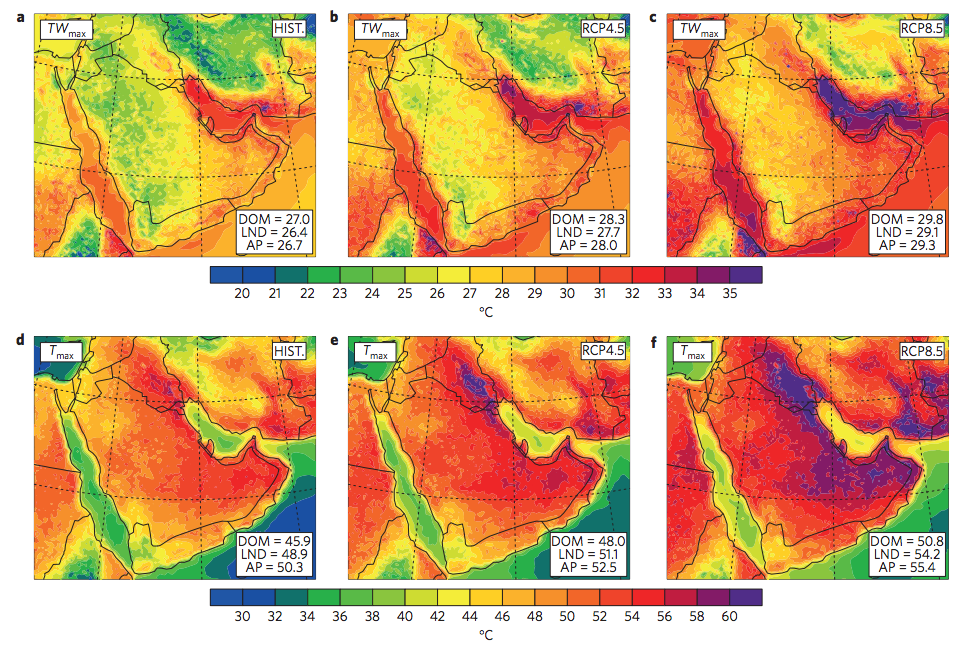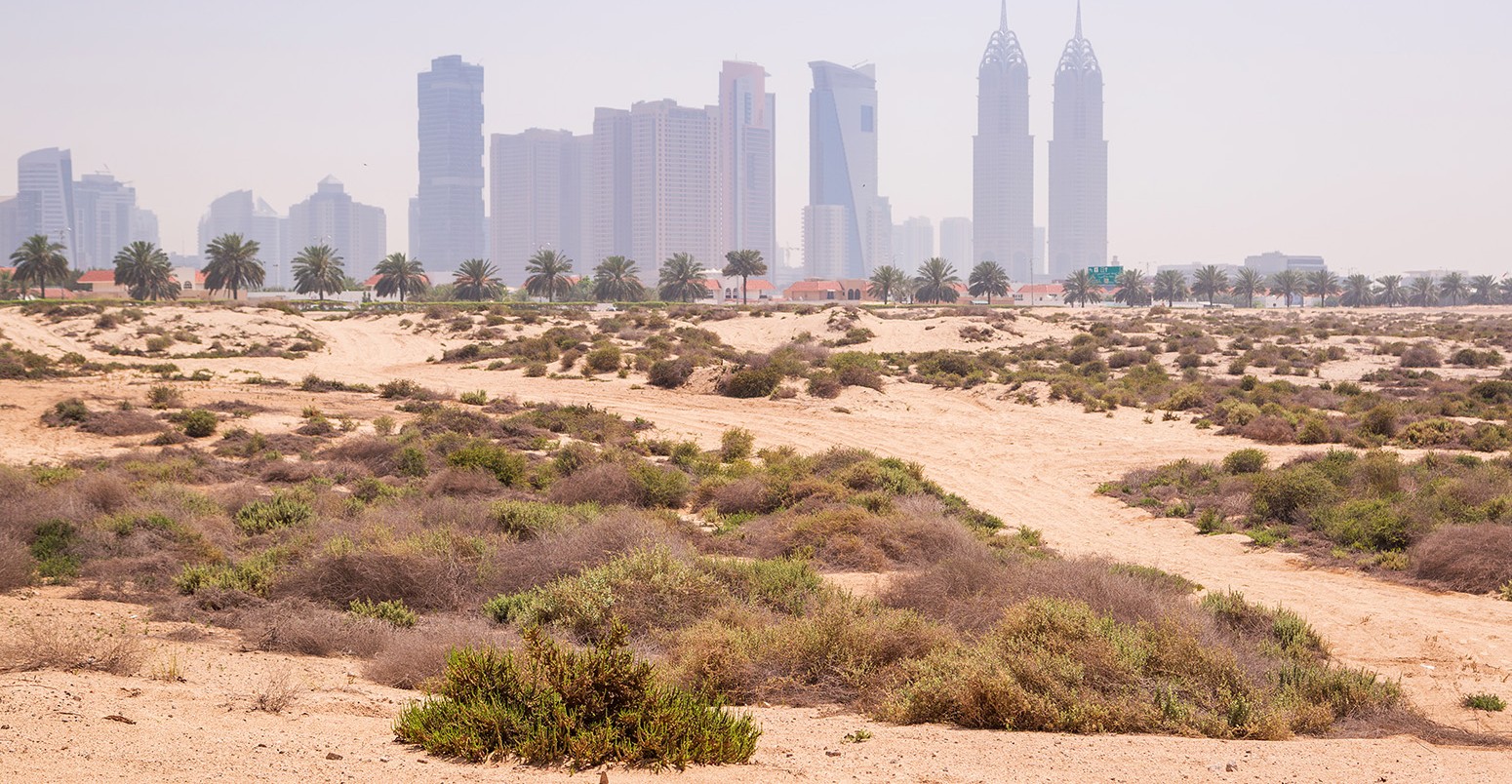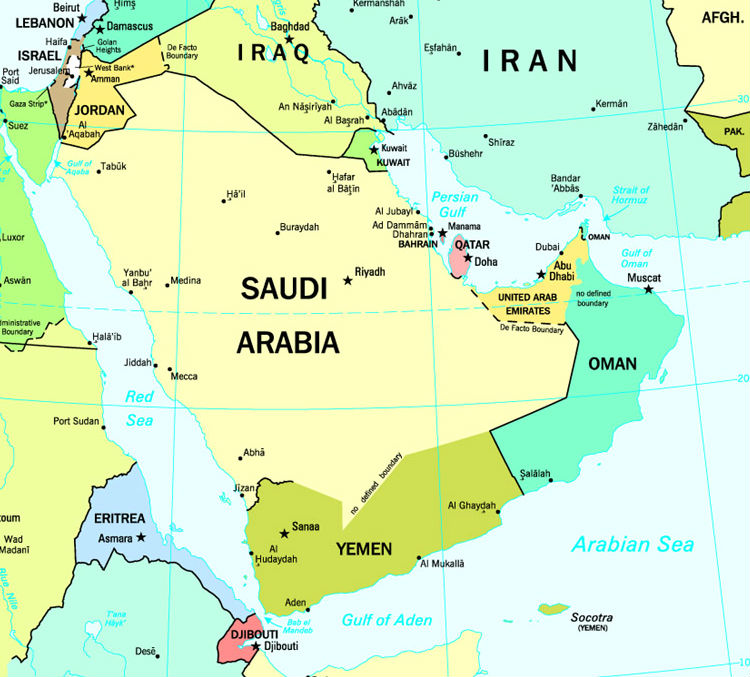Heat and humidity could make parts of the Middle East ‘unbearable’ by 2100
Robert McSweeney
10.26.15Robert McSweeney
26.10.2015 | 4:01pmConditions in the Middle East could become so hot and humid by the end of the century that being outside for more than six hours would be intolerable, a new study says.
Under a high emissions scenario, climate change would mean summer conditions occasionally exceed the threshold for human survival in some of the region’s major cities, such as Abu Dhabi, Doha and Dubai, the researchers say.
Hot and humid
The human body is pretty clever at controlling its temperature. In hot weather, the body cools you down through sweating and by increasing blood flow to the skin to help radiate away heat.
In very hot and humid conditions – when the air is already heavily-laden with water vapour – your sweat doesn’t evaporate, and the body can struggle to shed heat. A study published in 2010 identified a threshold “wet-bulb” temperature of 35C, above which any length of time in these conditions would be intolerable – even for fit and healthy people.
Wet bulb temperature is a combined measure of both temperature and humidity. It takes into account the cooling influence of evaporation, so will usually be lower than the standard “dry-bulb” temperature that a weather forecast gives you.
The higher the wet bulb temperature, the more hot and sticky the air feels. On a muggy summer’s day in Europe or North America, wet bulb temperature might hit 23C. In the Middle East, it can creep over 31C, but 35C has not been recorded anywhere on Earth.
The new study, published in Nature Climate Change, finds that parts of the Middle East may exceed the 35C threshold of human tolerance “once every 10-20 years” by the end of the century.
Persian Gulf
The study focused on the Persian Gulf and its surrounding countries, such as Saudi Arabia, Iran, Yemen and the United Arab Emirates.
The region isn’t just hot, but can also get very humid, and stay that way for long periods of time. Using three climate models, the researchers estimated changes in dry and humid heat in the region by 2071-2100.
They considered two scenarios, known as representative concentration pathways, for how we deal with rising global carbon emissions. In RCP4.5, emissions are curbed and atmospheric carbon dioxide levels stabilise at 650 parts per million (ppm) by 2100 – roughly 250ppm higher than they are now. In RCP8.5, emissions remain high and carbon dioxide levels rise to around 1,370ppm by 2100. Global emissions are currently tracking just above the RCP8.5 scenario.
Under RCP8.5, the study found the 35C wet-bulb threshold would be breached for a six hour period at least once every 10-20 years by the end of the century along the Persian Gulf coast. This area includes major cities such as Dubai, Doha, and Abu Dhabi.
In the same coastal area, summer conditions would exceed 32C more often than not, lead author Dr Jeremy Pal, from Loyola Marymount University in Los Angeles, told a press conference. Even these conditions are “extremely dangerous conditions for most humans,” he said.
You can see from deep red areas of the top row of maps below that coastal areas around the Persian Gulf, Red Sea and Arabian Sea are particularly at risk from high wet-bulb temperatures. Inland areas (bottom row of maps) suffer more from very high dry temperatures, such as Kuwait City, which is projected to hit 60C during some future summers under RCP8.5.
Under RCP4.5, where carbon emissions are stabilised, temperatures still rise, but do not reach the 35C threshold in any part of the region.

Maps of observed and projected wet-bulb (top row) and dry-bulb (bottom row) temperatures for the Persian Gulf and surrounding countries. Maps show results for recent climate of 1976 to 2005 (left-hand maps), and future climate under RCP4.5 (middle) and RCP8.5 (right-hand). Source: Pal & Eltahir (2015)
‘Severely impacted’
While technology such as air conditioning could make indoor conditions far more comfortable, “even the most basic outdoor activities are likely to be severely impacted” by such high wet-bulb temperatures, the paper says.
The Muslim pilgrimage, the Hajj, is one example of an outdoor activity that could become “hazardous to human health,” the paper says. Each year, more than two million Muslims undertake the pilgrimage to Mecca – near Saudi Arabia’s Red Sea coast – where they pray outdoors over several days. When the Hajj falls during summer, hot and humid conditions under RCP8.5 could be dangerous, particularly for elderly pilgrims, the study warns. Under RCP4.5, the wet-bulb temperature would “only be about 2C warmer” than the current climate, it adds.
The extreme conditions along the Persian Gulf could also limit expansion of development along the coast, the researchers say, and make outdoor industries, such as construction, port operation, and oil and gas exploitation, more dangerous for workers.
However, the study doesn’t consider how individual responses to such extreme conditions, says Prof Kristie Ebi, a professor in the Department of Global Health at the University of Washington, who wasn’t involved in the study. She tells Carbon Brief:
Decades of physiological research highlights the variability in individual response to heat stress, showing that tolerance of heat stress varies based on fitness, presence of chronic diseases, use of certain drugs, clothing, level of activity, acclimatisation, and other factors.
This means some people will be more sensitive to extreme conditions than others, she says. Using a six hour period of exposure also assumes that people wouldn’t take action to cool themselves down, Ebi adds:
Most people would at least seek shade if not air conditioned spaces. While there are outdoor jobs where there are limited opportunities for cooling down, many countries have regulations to prevent excessive heat exposure.
In Saudi Arabia, outdoor workers aren’t allowed to work between midday and 3pm, for example.
But heat stress is a “serious and growing public health impact of increasing global and regional temperatures,” says Ebi.
The study highlights how curbing emissions can help avoid breaching the 35C threshold. Reducing emissions “significantly reduce[s] the severity of the projected impacts,” the paper says, and countries in the region “stand to gain considerable benefits by supporting global mitigation efforts,” it concludes.
Main image: Sandy scenery of Dubai at the Jumeirah Beach, UAE. Credit: Patryk Kosmider/Shutterstock.com.
Pal, S. J. and Eltahir, E. A. B. (2015) Future temperature in southwest Asia projected to exceed a threshold for human adaptability, Nature Climate Change, doi:10.1038/nclimate2833
-
Heat and humidity could make parts of the Middle East ‘unbearable’ by 2100
-
Conditions in the Middle East could become so hot and humid by the end of the century that being outside for more than six hours would be intolerable, a new study says



